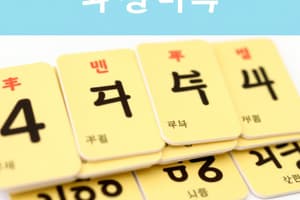Podcast
Questions and Answers
What did the Sino-Soviet Treaty of Friendship, Alliance and Mutual Assistance achieve for China?
What did the Sino-Soviet Treaty of Friendship, Alliance and Mutual Assistance achieve for China?
- It resulted in joint military operations against Western Europe.
- It prohibited China from forming alliances with other nations.
- It led to mutual recognition of each country's communist government. (correct)
- It established China as the dominant communist power in Asia.
How did Mao's view of the revolution differ from Stalin's?
How did Mao's view of the revolution differ from Stalin's?
- Mao believed the revolution ended in 1949.
- Mao supported peaceful co-existence with the West.
- Mao saw the transformation to communism as a continuous process. (correct)
- Mao prioritized the urban population over the rural peasants.
What common enemy strengthened the relationship between China and the USSR?
What common enemy strengthened the relationship between China and the USSR?
- The USA (correct)
- Japan
- Germany
- Britain
Which event caused China to doubt the USSR's commitment to communism?
Which event caused China to doubt the USSR's commitment to communism?
Why did the CCP believe their form of communism was superior to that of the USSR?
Why did the CCP believe their form of communism was superior to that of the USSR?
What event led to the Dalai Lama fleeing to India in 1959?
What event led to the Dalai Lama fleeing to India in 1959?
What was a fundamental difference in ideology between Stalin and Mao regarding communism?
What was a fundamental difference in ideology between Stalin and Mao regarding communism?
What was Khrushchev's stance on revolutionary activity?
What was Khrushchev's stance on revolutionary activity?
What characterized Tibetan autonomy under CCP control?
What characterized Tibetan autonomy under CCP control?
How did the Cultural Revolution impact religious buildings in Tibet?
How did the Cultural Revolution impact religious buildings in Tibet?
What term did Khrushchev use to criticize the USSR's previous approach under Stalin?
What term did Khrushchev use to criticize the USSR's previous approach under Stalin?
How did the CCP see the USSR's model of revolution after Khrushchev's reforms?
How did the CCP see the USSR's model of revolution after Khrushchev's reforms?
What was a significant result of the Korean War concerning foreign interest in Southeast Asia?
What was a significant result of the Korean War concerning foreign interest in Southeast Asia?
Which country did North Vietnam initially rely on for support during the war against South Vietnam?
Which country did North Vietnam initially rely on for support during the war against South Vietnam?
How did the outcome of the Vietnam War affect China's relations with North Vietnam?
How did the outcome of the Vietnam War affect China's relations with North Vietnam?
What military action did China take in 1979 regarding Vietnam?
What military action did China take in 1979 regarding Vietnam?
Flashcards are hidden until you start studying
Study Notes
Sino-Soviet Relations
- In 1949, Stalin welcomed the establishment of the People's Republic of China, viewing it as a victory for communism.
- Mao Zedong visited Moscow in 1950, leading to the Sino-Soviet Treaty of Friendship, Alliance, and Mutual Assistance.
- The treaty recognized the Chinese communist government and provided military equipment.
- Both countries supported North Korea during the Korean War, further strengthening relations.
- The shared enemy, the USA, who was building anti-communist alliances in Asia, also fostered closer ties.
- However, differences emerged in their interpretations of communism.
- Stalin believed that the Chinese revolution should prioritize peasant needs, viewing the Soviet model as a blueprint.
- Mao saw the revolution as a continuous process of transformation towards a classless society.
- After Stalin's death, Khrushchev denounced Stalinism and proposed peaceful coexistence with the West, a concept rejected by both Stalin and Mao.
- Khrushchev's policy of peaceful coexistence led to accusations of "revisionism" against the USSR, suggesting a deviation from the Marxist-Leninist principles.
- China viewed the USSR's willingness to coexist with the West as a betrayal of communist ideals, raising doubts about Soviet leadership.
- China felt its brand of communism was superior due to its experience with Western imperialism.
China's Relations with Tibet
- Tibet, with its unique language and culture, served as a Buddhist center from the 7th century onwards.
- Chinese involvement in Tibetan affairs deepened in the 18th century, particularly through religious matters.
- The CCP granted Tibet autonomy in religion after taking power, but controlled external affairs and other aspects of its governance.
- In 1959, a revolt erupted in Lhasa, fueled by rumors of the Dalai Lama's potential kidnapping, forcing him to flee to India.
- The PRC suppressed the rebellion with military force, with the unrest receiving American support.
- During the Cultural Revolution, Red Guards destroyed religious buildings in Tibet between the 1960s and 1970s.
- After Mao's death, policies shifted towards promoting tourism in Tibet, including plans for a high-speed railway connecting Beijing and Lhasa.
China's Relations with Vietnam
- Vietnam relied on China for support and military supplies during the war against South Vietnam and the USA.
- However, during the Cultural Revolution, North Vietnam shifted its dependence to the Soviet Union for assistance.
- Tension arose between China and Vietnam, marked by criticism from North Vietnam regarding the Cultural Revolution.
- Relations worsened after North Vietnam's victory in the war and the unification of Vietnam as a communist state.
- In 1979, China invaded the northern regions of Vietnam with 200,000 troops.
Studying That Suits You
Use AI to generate personalized quizzes and flashcards to suit your learning preferences.




